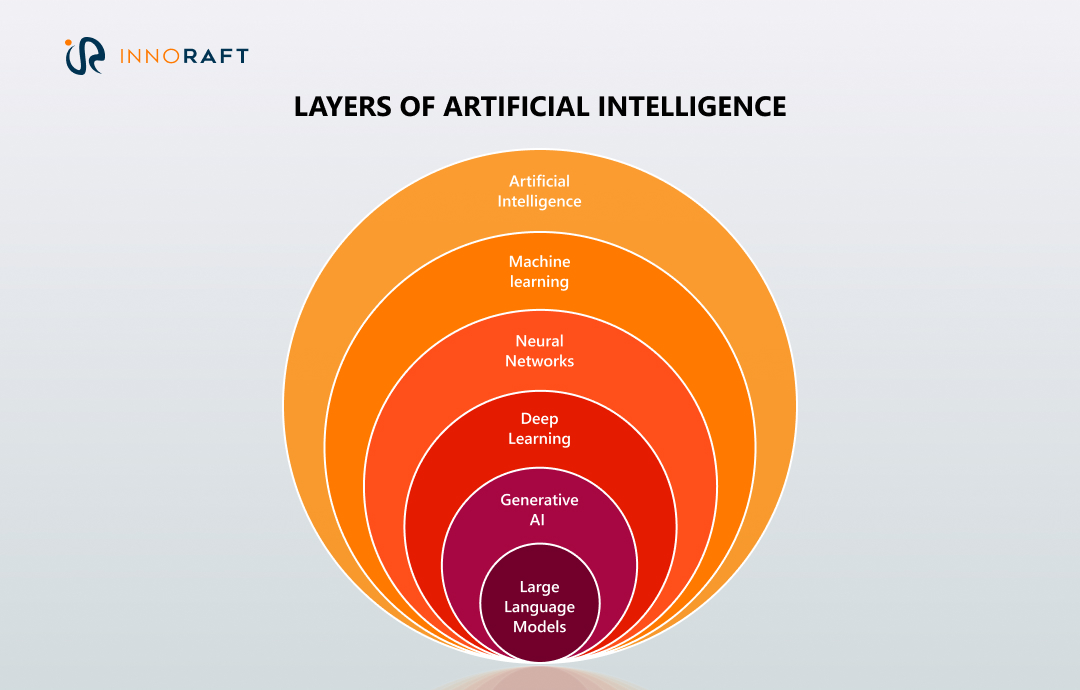Innovation is the new baseline for business success. But the path from idea to execution is often slow and resource-intensive. You face a constant tension between the need to build new solutions fast, whether it is functional software, strategic models, or creative assets, and the hard limits of time and human capacity.
So, what exactly can help you take raw ideas and translate them into tangible, usable output?
Generative AI has emerged as the functional answer to this efficiency gap. It represents a fundamental shift from software that merely organizes or analyzes your data to software that actively builds with it. By understanding how generative AI works, you can move beyond viewing it as a simple novelty and begin seeing it as a catalyst for operational speed. This guide explores the mechanics, broad applications, and strategic implementation of GenAI to help you navigate this changing landscape.
What Exactly is Generative AI?
Generative AI is a subset of artificial intelligence designed to generate new, original artifacts, including code, simulations, text, and audio rather than just analyzing existing data.
While traditional AI systems excel at pattern recognition and prediction (like detecting credit card fraud or classifying emails), Generative AI takes a step further. It uses the patterns it has learned to synthesize entirely novel outputs that mirror the training data but are not identical to it. It effectively turns "read-only" archives of human knowledge into "write-enabled" tools, illustrating how powerful types of generative AI models can be when creating new content. It effectively turns "read-only" archives of human knowledge into "write-enabled" tools.
The foundation of GenAI rests on three pillars:
- Data: Massive datasets (Github repositories, academic papers, image libraries) that serve as the learning material.
- Architecture: The underlying structures, such as Transformers or GANs, that allow the model to understand context and causal relationships.
- Compute: The immense processing power required to train these models and generate outputs in real-time.
To visualize where GenAI sits in the broader technology landscape, consider the relationship between general AI, Machine Learning, and Deep Learning, and how foundation models in AI underpin many of today’s most advanced GenAI capabilities.

How is GenAI Created?
Engineers create these models through a process called "training." They feed the AI vast amounts of unlabeled data. The model plays a game of self-supervision, where it hides a part of the data from itself and tries to guess what is missing. Over billions of attempts, it builds a statistical understanding of how logic, syntax, or pixels fit together. Once this "Foundation Model" is trained, it can be fine-tuned for specific, high-value tasks like debugging Python code or drafting legal contracts, a core capability enabled by foundation models in AI.
How does GenAI Work?
Generative AI works by converting your input into numerical data, processing it through a complex neural network to predict the most likely "next step," following the GenAI workflow explained through layers of learned patterns, and converting that prediction back into a human-readable or machine-executable format.
The workflow is a sophisticated probabilistic process that reflects the GenAI workflow explained by modern foundation models. When you prompt a tool to write a function or design a prototype, you are not searching a database for an existing answer, you are triggering a fresh creation process.
Here is the step-by-step workflow of a typical GenAI interaction:
Input Processing (Tokenization):
You provide a prompt. The system breaks your request down into smaller units called "tokens" (words, characters, or code snippets) or converts an image into a grid of numbers.
Encoding:
These tokens are mapped to high-dimensional vectors, a core part of how generative AI works. This means the AI converts concepts into long lists of numbers that represent their meaning. It understands that "def" in Python is related to defining a function, just as "King" is related to "Royalty."
Retrieval-Augmented Generation (RAG):
In advanced workflows requiring high accuracy or private data, RAG acts as a bridge between the model and external knowledge. Before generating an answer, the system takes your encoded prompt and searches a trusted external database (Vector DB) for relevant, up-to-date information. It retrieves this specific context and injects it into the workflow, ensuring the model bases its answer on facts rather than just training memory.
Context Analysis (The "Attention" Mechanism):
This is the breakthrough feature of modern Transformers, one of the most influential types of generative AI models. The model looks at all your tokens at once and decides which ones are most important to the logic. It understands dependencies, ensuring that a variable defined at the start of a code block is used correctly at the end.
Generation:
The model predicts the next token in the sequence based on probability. It does not just pick the highest probability every time; it uses a "temperature" setting to introduce slight randomness, which prevents repetitive loops.
Decoding:
The chosen mathematical vectors are converted back into human language, code, or image pixels.
Refinement:
In many systems, a final filter checks the output for safety, bias, and coherence before presenting it to you.
Different models handle this differently, reflecting the diverse types of generative AI models in use today. Transformers (like GPT) are great at sequential data like text and code. Diffusion Models (like Stable Diffusion) add noise to data until it is unrecognizable, then learn to reverse the process to reconstruct clear data from static. GANs (Generative Adversarial Networks) pit two AIs against each other, one creates, the other critiques, until the output is indistinguishable from reality.
How is GenAI Being Applied Across Industries?
The emerging impact of AI across our lives and industries are evident. In the same way, generative AI is also finding utility in almost every sector where complex problems need to be solved or new assets need to be created.
This technology is moving beyond novelty and entering core business workflows as applications of GenAI in industries continue to expand.
- Software Development: Developers use coding assistants to auto-complete code blocks, refactor legacy codebases, and generate unit tests. This significantly speeds up the development lifecycle and reduces technical debt.
- Pharmaceuticals: Researchers use generative models to predict protein structures and simulate molecular interactions, showcasing one of the most impactful generative AI use cases in drastically reducing the timeline for drug discovery.
- Finance: Analysts use GenAI to synthesize vast amounts of financial news into daily briefings and to detect complex fraud patterns by generating synthetic transaction data to train detection models.
- Marketing and Sales: Teams use GenAI to draft personalized outreach at scale, creating ad variations and content strategies that adapt to user behavior in real-time, one of the most active generative AI use cases in marketing.
- Customer Support: Intelligent agents now handle complex customer queries with natural, conversational responses rather than rigid script-following, improving resolution rates.
What are The Benefits and Challenges?
Adopting Generative AI brings immense potential for productivity, but it introduces specific risks that you must manage, a balance at the heart of the benefits and challenges of generative AI.
Benefits
- Speed and Scale: You can produce prototypes, code functions, and summaries in seconds rather than hours.
- Problem-Solving Augmentation: It acts as an endless logic partner, offering debugging solutions and strategic angles you might not have considered.
- Personalization: You can tailor communication with Gen AI in customer services and user experiences to individual preferences instantly.
- Skill Accessibility: It democratizes technical skills; a marketer can write basic SQL queries, and a coder can generate visual assets.
Challenges
- Hallucinations: GenAI models can confidently state facts or write code libraries that do not exist. They prioritize plausibility over truth.
- Bias: Because models are trained on internet data, they can inherently reproduce societal biases regarding gender, race, and culture.
- IP and Copyright: The legal frameworks regarding who owns AI-generated code or art, and whether training data was used fairly, are still being established.
- Security: There are risks of "prompt injection" attacks or sensitive data leakage if proprietary code or financial data is pasted into public models.
What are The Best Practices for Implementation?
Successful GenAI adoption requires a strategic approach that prioritizes human oversight and clear objectives, aligning with established best practices for generative AI implementation.
You should not just "turn on" AI and hope for the best. Follow these guidelines:
- Start with a Clear Use Case: Do not use GenAI just to use it. Identify a specific bottleneck, such as "slow QA testing cycles" or "delayed market research," and apply the tool there.
- Keep a Human in the Loop (HITL): AI should be a drafter, not the final publisher. Ensure a human expert reviews outputs for accuracy, security, and brand alignment before they go live.
- Prioritize Data Privacy: Use enterprise-grade versions of tools that guarantee your data is not used to train the public model. Sanitize data before feeding it into any AI system.
- Focus on Prompt Engineering: The quality of the output depends on the quality of the input. Train your team on how to write detailed, contextual prompts to get the best results.
- Iterate and Update: AI models change weekly. Your workflows should be flexible enough to adapt to new capabilities as they are released.
Conclusion
Generative AI represents a transition from static software to dynamic, creative partners. It offers a solution to the modern scalability crisis and opens new doors for innovation across every industry, from coding to creative design. However, it requires a disciplined approach to manage the risks of accuracy and security, a reality central to the benefits and challenges of generative AI.
By understanding the mechanics of how GenAI works and respecting the need for human oversight, you can harness this power effectively, grounding your approach in a clear Generative AI definition of what the technology can and cannot do. The goal is not to automate away your ingenuity, but to remove the friction that stands between your ideas and their execution.
Key Takeaways
- It creates, it doesn't just analyze: GenAI generates novel text, code, and simulations rather than just categorizing existing data.
- It creates via prediction: The core mechanic is probabilistic prediction of the next token or pixel, not database retrieval.
- Human oversight is mandatory: Due to the risk of hallucinations, a "Human in the Loop" workflow is essential for business applications.
- Input quality matters: The specificity and context of your prompt determine the quality of the result.
- Security is a priority: Enterprise adoption requires strict data governance to prevent IP and data leakage.
Ready to leverage the benefits of GenAI for your business? Connect with our experts today.
FAQ
Frequently Asked Questions
Didn’t find what you were looking for here?


